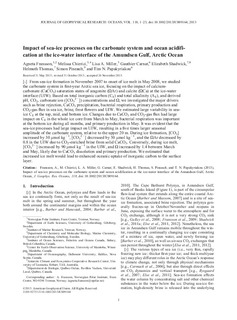| dc.identifier.citation | Fransson, A., M. Chierici, L. A. Miller, G. Carnat, E. Shadwick, H. Thomas, S. Pineault, and T. N. Papakyriakou (2013), Impact of sea-ice processes on the carbonate system and ocean acidification at the ice-water interface of the Amundsen Gulf, Arctic Ocean, J. Geophys. Res. Oceans, 118, 7001–7023, doi:10.1002/2013JC009164. | |
| dc.description.abstract | From sea-ice formation in November 2007 to onset of ice melt in May 2008, we studied the carbonate system in first-year Arctic sea ice, focusing on the impact of calcium-carbonate (CaCO3) saturation states of aragonite (ΩAr) and calcite (ΩCa) at the ice-water interface (UIW). Based on total inorganic carbon (CT) and total alkalinity (AT), and derived pH, CO2, carbonate ion ([CO32−]) concentrations and Ω, we investigated the major drivers such as brine rejection, CaCO3 precipitation, bacterial respiration, primary production and CO2-gas flux in sea ice, brine, frost flowers and UIW. We estimated large variability in sea-ice CT at the top, mid, and bottom ice. Changes due to CaCO3 and CO2-gas flux had large impact on CT in the whole ice core from March to May, bacterial respiration was important at the bottom ice during all months, and primary production in May. It was evident that the sea-ice processes had large impact on UIW, resulting in a five times larger seasonal amplitude of the carbonate system, relative to the upper 20 m. During ice formation, [CO2] increased by 30 µmol kg−1, [CO32−] decreased by 50 µmol kg−1, and the ΩAr decreased by 0.8 in the UIW due to CO2-enriched brine from solid CaCO3. Conversely, during ice melt, [CO32−] increased by 90 µmol kg−1 in the UIW, and Ω increased by 1.4 between March and May, likely due to CaCO3 dissolution and primary production. We estimated that increased ice melt would lead to enhanced oceanic uptake of inorganic carbon to the surface layer. | |
